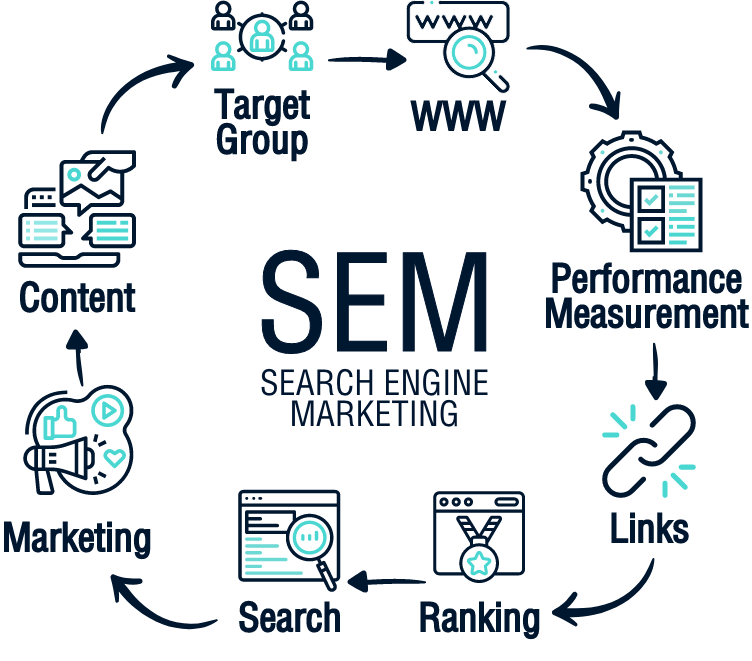Introduction
Search Engine Marketing (SEM), in today’s fast-moving digital world where competition for visibility can be intense, is becoming an invaluable asset to businesses seeking to effectively connect with their target audiences online. SEM includes pay-per-click (PPC) advertising as well as search engine optimization (SEO) strategies; its comprehensive nature enables businesses to achieve higher search engine rankings, increase website traffic and boost conversions – in this blog we explore its benefits and best practices so your brand can maximise its full potential and take off like never before!
- Master Search Engine Marketing (SEM):
Search engine marketing (SEM) involves harnessing search engines like Google, Bing or Yahoo to promote and expand the reach of your products or services by reaching those searching for them directly on search engine result pages (SERPs) as well as employing organic SEO strategies that enhance website visibility and boost sales leads. SEM encompasses paid advertisements displayed directly to potential customers searching for related goods or services while SEM encompasses paid advertisements appearing directly within SERPs as well as organic strategies designed to maximize SEO results and boost website performance through SEO techniques and organic efforts that improve SERP visibility by increasing organic SEO strategies implemented organically via SEO strategies used in SERPs as well as organic strategies used in SEO techniques for optimizing website visibility
-
Benefits of Search Engine Marketing (SEM):
Instant Visibility on SERPs (Search Engine Results Pages): PPC ads provide instant visibility when relevant keywords are typed into search engines like Google and Bing; thus enabling your business to appear prominently when relevant searches come through for its products/services.
Precise Targeting: Search engine marketing allows for precise targeting of ads based on factors like location, keywords, demographics and user behaviour; making certain your message reaches its intended recipient(s).
Measurable Results: Search Engine Marketing offers comprehensive analytics that allow you to monitor the success of your ads and campaigns, helping you assess ROI accurately while adapting strategies appropriately.
Increased Brand Recognition: Prominence in search results fosters brand recognition and credibility, building trust among potential customers while strengthening loyalty to your company.
-
Pay-Per-Click Advertising (PPC):
PPC advertising (pay per click or PPC for short) is a paid marketing model where advertisers pay a fee every time their ad is clicked. Businesses bid on keywords relevant to their product or services that users enter in search engines such as Google; when those searchers type them in, PPC ensures your ad appears at either the top or bottom of SERPs for instant visibility – increasing conversion chances by reaching those actively searching.
- Search Engine Optimization (SEO):
SEO (Search Engine Optimization) is the practice of optimising a website in order to boost its organic rankings on search engine result pages. By producing high-quality, relevant content and optimising on-page elements like meta tags and headings while building authoritative backlinks you can increase its organic visibility within organic search results and drive steady organic traffic growth over time. SEO should be seen as a long-term investment that builds your credibility with search engines while driving consistent organic traffic streams to your site.
-
Best Practices for Efficient SEM:
Keyword Research: Conduct thorough keyword research as the cornerstone of successful SEM strategies tips. Locate relevant and high-converting keywords to target in PPC campaigns while optimising website content for organic search.
Engaging Ad Copy: Craft compelling ad copy that clearly articulates your USPs and encourages users to click your ads.
Landing Page Optimization: Optimise your landing pages so they are in line with ad content and provide seamless user experiences, to boost conversion rate significantly. An efficiently optimised landing page can have an exponential effect.
Regular Monitoring and Optimization: Maintain a regular review and optimization cycle on all PPC campaigns to boost click-through rates (CTR) and conversion rates.
Quality Content Creation: Produce high-quality and relevant content that offers value to your target audience in order to increase website authority and organic search ranking positions. This will enhance their experience on your site while simultaneously strengthening organic search rankings.
Conclusion
Search engine marketing (SEM) is an invaluable strategy that empowers businesses to target their ideal audience with precision, and experience extraordinary growth. By harnessing both PPC advertising and SEO together, businesses can maximise online exposure, attract qualified leads and drive conversions while adhering to best practices of SEM in adapting to an ever-evolving digital environment – and continually optimise strategies through measurement of results gathered over time – creating a competitive edge and standing out amongst crowded digital spaces with an optimised SEM plan in place!

